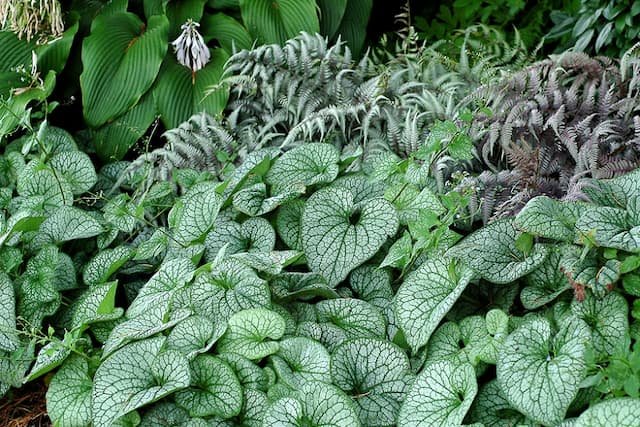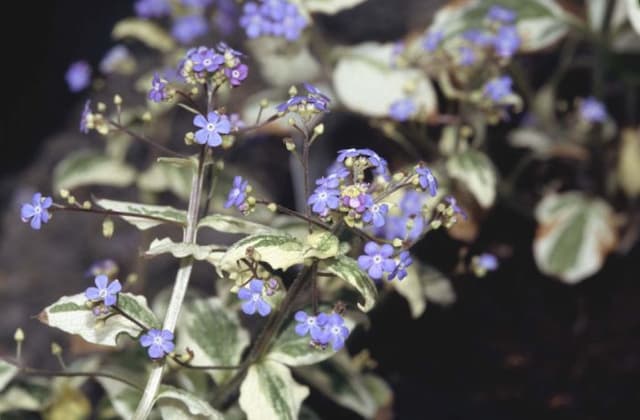Lungwort Pulmonaria 'Little Star'

ABOUT
Pulmonaria 'Little Star' is a charming perennial plant notable for its ornamental foliage and dainty flowers. The leaves of this plant are characteristically mottled with silver spots or splotches, creating a striking contrast against the deep green background. This variegation adds texture and interest even when the plant is not in bloom. The flowers of Pulmonaria 'Little Star' start as pink buds and typically change to a lovely shade of blue as they mature. These blooms are small, delicate, and bell-shaped, appearing in clusters on stems that rise above the foliage. The plant is appreciated for its long blooming period, which adds color to the garden during the transition from winter to spring.
About this plant
 Names
NamesFamily
Boraginaceae
Synonyms
Lungwort, Bethlehem Sage, Little Star Lungwort, Jerusalem Cowslip
Common names
Pulmonaria 'Little Star'
 Toxicity
ToxicityTo humans
Lungwort 'Little Star' is generally not considered to be toxic to humans. It is not known to contain any substances that are harmful when ingested in normal quantities typically used in the landscape or garden context. However, it's always a good idea to avoid eating any plant material unless it's known to be edible, and people with sensitive skin may sometimes experience irritation from handling plants.
To pets
Lungwort 'Little Star' is not known to be toxic to pets. This plant is not listed as toxic for dogs or cats by the ASPCA (American Society for the Prevention of Cruelty to Animals) or other major animal welfare groups. As with humans though, it is still advisable to prevent pets from ingesting plants as they may cause gastrointestinal upset or an allergic reaction in sensitive individuals.
 Characteristics
CharacteristicsLife cycle
Perennials
Foliage type
Deciduous
Color of leaves
Variegated
Flower color
Pink
Height
1 foot (30 cm)
Spread
1 foot (30 cm)
Plant type
Herb
Hardiness zones
3 to 9
Native area
Europe
Benefits
 General Benefits
General Benefits- Shade tolerance: Thrives in shaded areas where other plants may struggle.
- Spring flowering: Produces vibrant blooms early in the season to brighten the garden.
- Drought resistance: Once established, it's relatively tolerant to short periods of drought.
- Wildlife attraction: Flowers provide nectar for bees and other pollinators in early spring.
- Ground cover: Forms a dense mat that can help suppress weeds and cover bare spots in the garden.
- Low maintenance: Requires minimal care once established, making it suitable for novice gardeners.
- Ornamental foliage: Attractive leaves provide visual interest even when not in bloom.
- Hardiness: Resilient in many climates and able to withstand cold winter temperatures.
- Soil adaptability: Can grow in a variety of soil conditions, although it prefers moist, well-drained soil.
 Medical Properties
Medical PropertiesThis plant is not used for medical purposes.
 Air-purifying Qualities
Air-purifying QualitiesThis plant is not specifically known for air purifying qualities.
 Other Uses
Other Uses- Lungwort 'Little Star' can be used in a butterfly garden as it attracts pollinators like bees and butterflies with its early spring flowers.
- The plant can serve as a living mulch, with its dense foliage suppressing weeds and retaining soil moisture when planted closely with other perennials or shrubs.
- Lungwort 'Little Star' can be used in shaded rock gardens, adapting well to the crevices between rocks while providing spring color.
- Pressed flower craft - the distinctive spotted leaves and colorful blooms can be pressed and used for creating natural art pieces.
- Dried flower arrangements - although not common, the flowers could be dried and added to bouquets for a unique texture and shape.
- Educational use in a garden to demonstrate plant adaptability, showcasing how Lungwort can thrive in shady, moist environments when other plants may struggle.
- Utilized as a border plant along walkways or paths, where the early blooms can be appreciated up close during the spring season.
- Lungwort 'Little Star' can offer aesthetic contrast when planted amongst ferns, providing a varying leaf shape and early season color.
- Since this plant is loved by bees, it can be used in a bee-friendly landscape project aiming to support local pollinator populations.
- Use in photography or art classes as a subject for botanical illustration or natural light photography, especially due to its distinctive leaf patterns and colors.
Interesting Facts
 Feng Shui
Feng ShuiPulmonaria 'Little Star', also known as Lungwort, is not typically used in Feng Shui practice.
 Zodiac Sign Compitability
Zodiac Sign CompitabilityLungwort is not used in astrology practice.
 Plant Symbolism
Plant Symbolism- Hope: Pulmonaria, commonly known as lungwort, is often associated with hope due to its early spring bloom, symbolizing the end of winter and the promise of new life.
- Resilience: Lungwort has the ability to thrive in shaded and challenging environments, representing one's capacity to persevere through tough conditions.
- Healing: Historically, lungwort was used in medicinal remedies for lung diseases, symbolizing healing and the restoration of health.
 Water
WaterLungwort 'Little Star' prefers consistently moist soil, so it's important to water when the top inch of soil feels dry to the touch. Typically, this means watering about once a week, but this can vary depending on the climate and weather conditions. Provide approximately one gallon of water per plant, ensuring you're watering deeply enough to reach the root zone. During periods of drought or extreme heat, you may need to water more frequently, while in cooler or rainy conditions, less watering may be required. Always monitor the soil moisture and adjust accordingly to prevent waterlogging or drying out.
 Light
LightLungwort 'Little Star' thrives best in partial to full shade conditions. The ideal spot for this plant is beneath the canopy of trees or on the north side of a building where it receives dappled sunlight. Direct afternoon sun can scorch the leaves, so it's crucial to avoid placing Lungwort 'Little Star' in a spot where it will be exposed to the harsh midday sun.
 Temperature
TemperatureLungwort 'Little Star' is hardy and can tolerate a temperature range from around 20 degrees to 80 degrees Fahrenheit. However, it prefers a cooler climate and thrives best when the temperature is between 50 degrees and 75 degrees Fahrenheit. This plant may struggle if exposed to temperatures outside of its tolerance range for extended periods.
 Pruning
PruningPruning Lungwort 'Little Star' promotes healthier growth and helps maintain its attractive shape. The best time for pruning is immediately after flowering in late spring or early summer. Cut back the spent flower stems and any damaged or brown leaves to encourage fresh foliage. This process only needs to be done once a year unless additional shaping or removal of damaged foliage is necessary.
 Cleaning
CleaningAs needed
 Soil
SoilLungwort 'Little Star' thrives in well-draining, humus-rich soil with a high content of organic matter. The ideal pH range for this plant is slightly acidic to neutral, between 5.5 and 7. To create the best soil mix for Lungwort, combine garden soil with compost and a bit of perlite or coarse sand to improve drainage. Mulching with organic material is also beneficial to maintain moisture and soil structure.
 Repotting
RepottingLungworts, including 'Little Star', generally don't require frequent repotting and can be repotted every 3 to 4 years. However, they should be divided and repotted if they outgrow their current container or if the soil becomes exhausted. Repotting is best done in the spring just as new growth begins.
 Humidity & Misting
Humidity & MistingLungwort 'Little Star' prefers a moderately humid environment, mimicking its natural woodland habitat. A humidity level of around 50% is ideal for this plant. Maintaining such humidity can be achieved by placing the plant in a naturally humid area like a bathroom or using a humidifier if needed.
 Suitable locations
Suitable locationsIndoor
Place in bright, indirect light with moist soil.
Outdoor
Part shade, moist soil, protect from afternoon sun.
Hardiness zone
3-8 USDA
 Life cycle
Life cyclePulmonaria 'Little Star', commonly known as Lungwort 'Little Star', begins its life as a seed, which when sown in well-draining, humus-rich soil and exposed to partial shade, will germinate to produce small rosettes of foliage. As it enters its vegetative stage, the plant develops its distinctive spotted or silver-speckled leaves, which are evergreen in milder climates and form a low, ground-covering mound. During early spring, it advances to the flowering stage, producing clusters of small, bell-shaped flowers that transition in color from pink to blue as they mature. After pollination by bees and other insects, the plant sets seed which can be dispersed to create new plants, continuing the reproductive cycle. In the post-flowering stage, the leaves may die back in hotter summers or remain if conditions are favorable, ready to regrow the following spring. Over time, Lungwort 'Little Star' can be divided and transplanted to propagate new plants, effectively starting a new individual lifecycle while the parent plant remains in its perennial cycle.
 Propogation
PropogationPropogation time
Spring
Pulmonaria 'Little Star', commonly known as lungwort, is generally propagated by division, which is the most popular method for this perennial plant. The best time to divide lungwort is in the spring or early fall when the weather is cool, which allows the plant ample time to establish roots before the extremes of summer heat or winter cold. To propagate by division, dig up the entire clump of the plant after flowering has finished or before new growth starts, and gently tease apart the roots into smaller sections, each with a good amount of roots and shoots. These sections can then be replanted immediately into prepared soil, spaced about 12 inches (around 30 centimeters) apart to allow for growth. Ensure they are planted at the same depth as they were previously growing and water well to help settle the soil around the roots.









